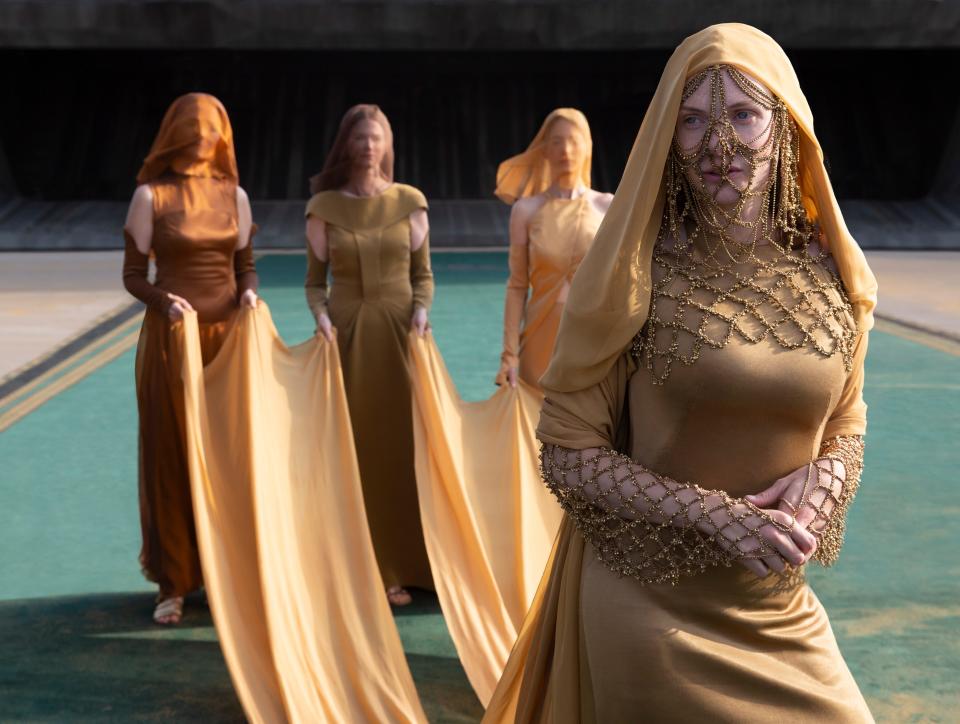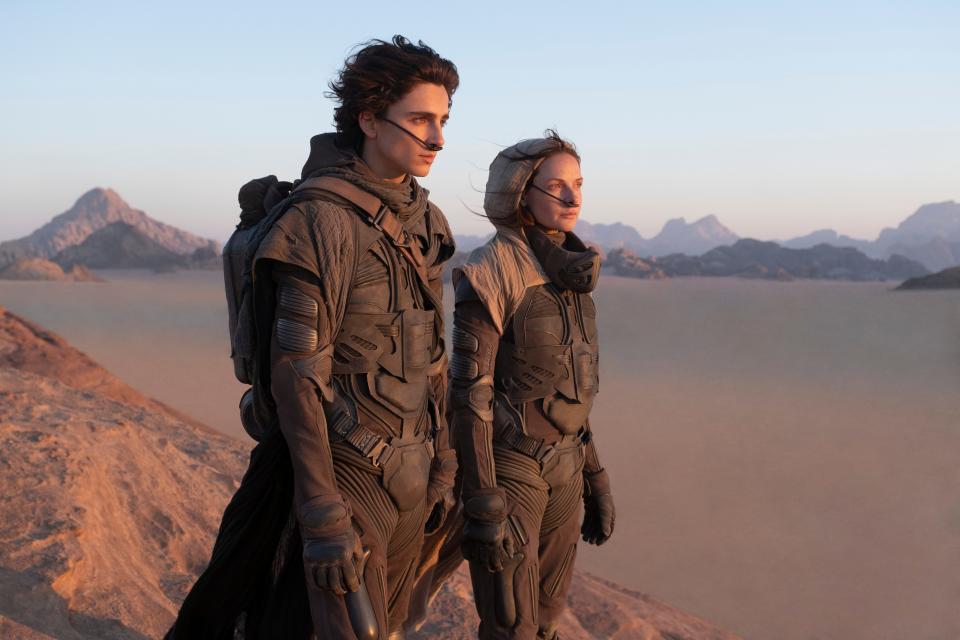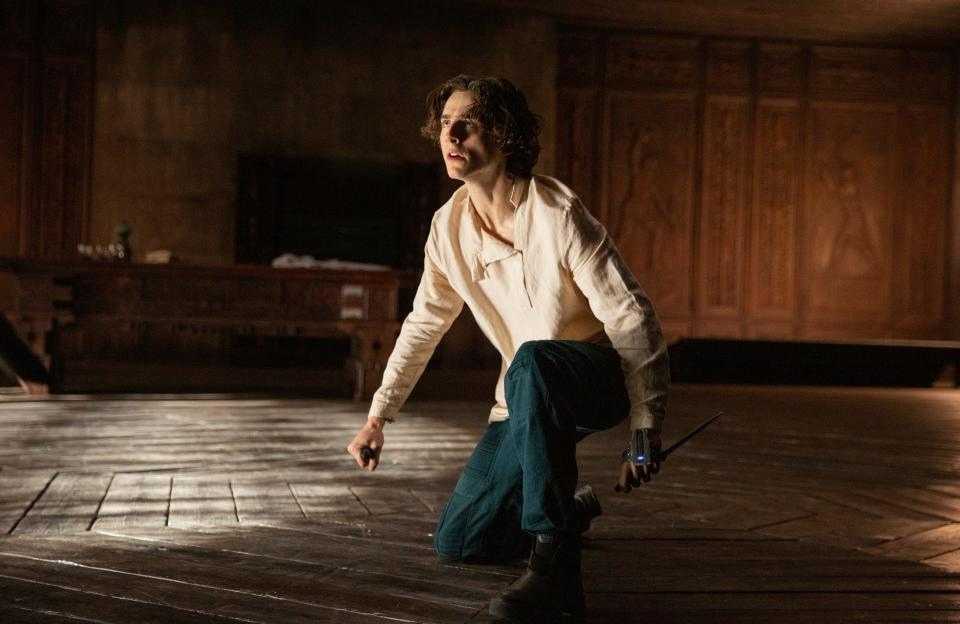What are ultimate shields and why do they fail? All your 'Dune' burning questions, answered
- Oops!Something went wrong.Please try again later.
- Oops!Something went wrong.Please try again later.
Beware, this story contains moderate spoilers about "Dune" (in theaters and streaming on HBO Max now).
Director Denis Villeneuve brings viewers to a whole new enthralling universe in his visually stunning "Dune," based on Frank Herbert's influential novels.
The Canadian director behind "Blade Runner 2049" gives minimal screen explanation to some fairly complex machinations, which can leave audiences pondering what's happening onscreen (our must-know guide will help).
For instance, what is the shield protecting people like Paul Atreides (Timothée Chalamet) and why does it fail? And what was it like to wear Lady Jessica's far-out dress?
We strive to answer your most burning "Dune" questions:
What to know from 'Dune' the book: Before seeing the movie (or how to sound like you've read it)
Stellan Skarsgård: How he transformed into 'Dune's 600-pound, often-naked 'monster' villain Baron Harkonnen

Rebecca Ferguson worked it in Lady Jessica's constricting dress. How did that go?
Lady Jessica goes all out upon her arrival on the desert planet Arrakis, donning a full-length, silk satin bias-cut dress – featuring a chain-mesh veil and gloves, a billowing cape and a 10-foot-long train that requires attention from her three ladies-in-waiting.
It's a statement dress for the arriving dignitary and one of the film's most memorable looks.
"I love the exquisiteness with which it was made," says Ferguson. But "to be honest, chainmail outfits – not comfortable, dude. And it's not comfortable being pushed into a corset and having to walk in high-heeled shoes."
Costume designer Jacqueline West concedes, "It took real grace for Rebecca to walk and turn in it."
'I hope I won't have to use it': Timothée Chalamet learned this new skill from 'Dune'

Ferguson was much more at home wearing the water-recycling stillsuits she and her screen son Paul Atreides don in the desert, even if it meant sprinting up real sand dunes on location in Jordan.
"Those suits were like the most comfortable onesies ever," Ferguson says. "Put me in those linen pajamas and throw me in a desert any day."

What are ultimate shields and why do they fail?
The "Dune" universe features a game-changing ultimate shield made to deflect fast objects and projectiles. Bullets, for instance, are irrelevant because they are deflected automatically. The only thing that can go through those shields are slow objects.
"That's why personal combat, the sword and the knife, are back in fashion, because it's the only way you can kill an opponent, to bring a blade slowly through that shield," Villeneuve says.
The ultimate shields explain the complex training scenes between Paul Atreides and Gurney Halleck (Josh Brolin), inspired by the book.

"It's a bit of a chess game, where you try to choreograph very fast moves in order to distract the opponent to bring a blade close enough to kill him," Villeneuve says.
The approach is used by the Harkonnen army with their explosive mines that slowly break through the shields to attack the Atreides fleets, despite the shield.
"I came with the idea for the Harkonnen army to use drifting mines that slowly go down like some sort of Tetris game from hell," Villeneuve says. "We are so used to fast objects. Playing with the speed was really exciting to do."

Which 'Dune' books are covered in the movie? And when is the sequel out?
The movie is based on 1965's "Dune," Frank Herbert's first novel in the sci-fi series. "The first book is so dense, so complex that I decided to make two movies out of it," Villeneuve says.
The current movie is actually " 'Dune: Part One,' which is half of the first book," he says. " 'Dune: Part Two' will cover the second half of the first book."
Villeneuve hasn't officially started on the second film, without a greenlight from Warner Bros. nor a studio budget. The director and cast are hoping "Dune" will prove the appetite for a second film to push it forward.
"I'm at peace with this idea. That's the gamble," Villeneuve says. "I put all my love and my passion into this project. I gave everything. But believe me, if I do a Part Two, this Part One will look like an appetizer."
Why was the gender switched for Dr. Liet Kynes?

"Dune" features a gender switch for one key character: British actress Sharon Duncan-Brewster portrays Dr. Liet Kynes, who serves as the liaison between the planet’s new administrator, Duke Leto Atreides (Oscar Isaac), and the Fremen, the planet’s native people.
The change was discussed at length by Villeneuve and fellow screenwriter Jon Spaihts, given that the book is dominated by male characters.
"That made perfect sense," Villeneuve says. "It didn't change the nature of the character at all, just made it more interesting, more contemporary."
"Frankly, I had a feeling there were too many boys around and it felt like we needed to bring more women onto the boat," Villeneuve says. "It was the right decision."

How did Baron Harkonnen escape the poison attack?
Gigantic villain Baron Harkonnen (Stellan Skarsgård) is nearly poisoned by the captured Duke Leto Atreides (Oscar Isaac), who releases the gas capsule placed in his mouth. But grievously harmed Harkonnen escapes by air, by kicking the anti-gravity device he needs to move about into instant overdrive.
""He can switch it on and off. That's what makes him hover and and float in the room," Skarsgård says. "So he just slaps that into full gear and up he goes."
After escaping, the Baron is forced to recover in a healing pool.
This article originally appeared on USA TODAY: 'Dune': Denis Villeneuve, Rebecca Ferguson answer burning questions

